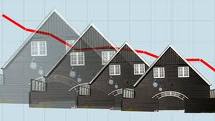 (Bloomberg) -- Purchases of new homes in the U.S. unexpectedly fell in February for a second month, a sign the recovery in the housing market may be uneven.
(Bloomberg) -- Purchases of new homes in the U.S. unexpectedly fell in February for a second month, a sign the recovery in the housing market may be uneven.
Sales dropped 1.6 percent to a 313,000 annual pace, the slowest since October, from a 318,000 rate in January that was weaker than previously reported, figures from the Commerce Department showed today in Washington. The median estimate of 78 economists surveyed by Bloomberg News called for 325,000.
Residential real estate is struggling to gain momentum as property values remain depressed by the threat of more foreclosures. Nonetheless, a pickup in hiring, growing incomes and mortgage rates near a record low are making houses more affordable, which may help underpin the market.
“There are signs of life in the market in certain regions, but we’re not seeing a broad-based recovery,” said Michelle Meyer, a senior U.S. economist at Bank of America Corp. in New York, who projected a 310,000 sales pace. “Builders are still competing with existing inventories. The spring selling season should show some modest improvement, but it will be limited.”
Stocks were little changed after the report, which was offset by a gain in energy companies. A measure of builder shares declined for the fifth day in the last six. The Standard& Poor’s 500 Index rose 0.1 percent to 1,394.74 at 11:28 a.m. in New York. The S&P Homebuilding Index (S15HOME), which includes Lennar Corp. and KB Home, slumped 1.8 percent.
Economists’ estimates for February sales ranged from 310,000 to 350,000. The rate for January was previously reported at 321,000.
Elsewhere today, French business confidence climbed more than projected in March after a gain in February that marked the first back-to-back increase in more than a year.
Taking Longer
The recent slowdown in housing demand has pushed up the amount of time it takes to sell a new home. There were 150,000 new dwellings on the market at the end of February, matching the prior month’s record low. The supply of homes at the current sales rate climbed to 5.8 months’ worth from 5.7 months in January.
Purchases, tabulated when contracts are signed, fell in two of the four U.S. regions, led by a 7.2 percent drop in the South. Sales declined 2.4 percent in the Midwest and rose 14 percent in the Northeast and 8 percent in the West.
The regional breakdown affected prices as demand fell in the South and Midwest where homes are less expensive and rose in the Northeast and West where they are costlier.



